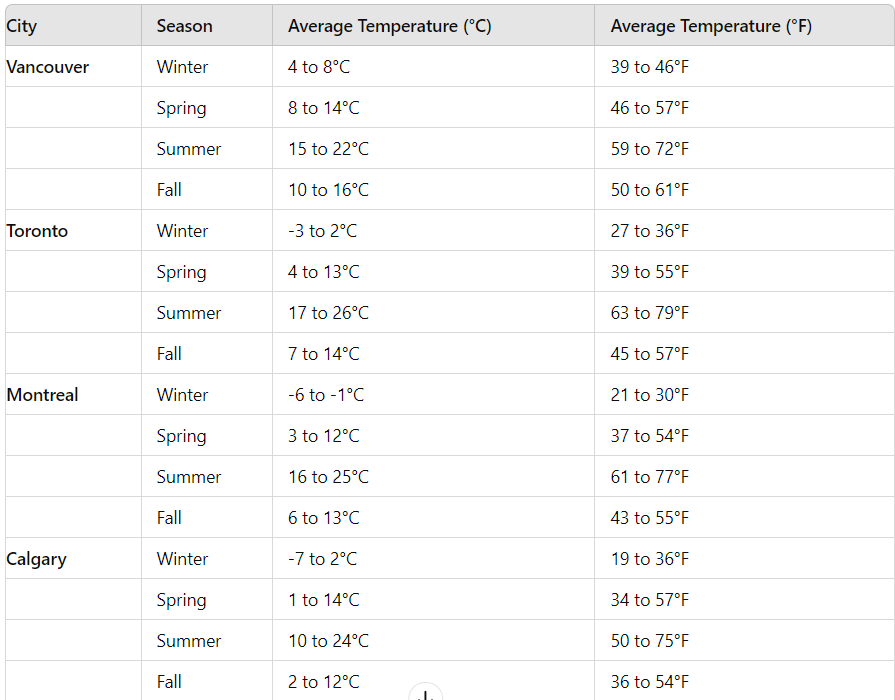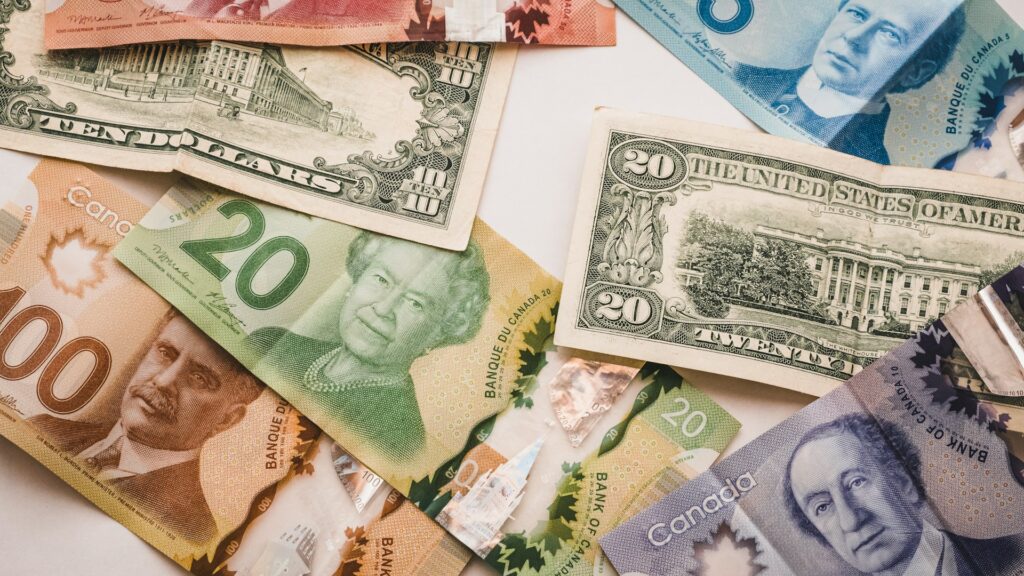Before Your Trip to Canada
Before starting your trip to Canada, it’s important to prepare thoroughly to ensure a smooth and enjoyable experience. Canada’s vast and diverse landscapes offer a range of activities and climates, so it’s important to pack appropriately for the season and region you’ll be visiting. Understanding the country’s entry requirements, such as necessary visas and travel documents, will help you avoid last-minute problems. In addition, familiarizing yourself with the local currency and financial practices can make your day-to-day transactions easier.
The Weather in Canada
Canada’s climate varies significantly depending on the region and the time of year, offering a range of weather conditions across the country. With its vast size, different areas experience different climates, from temperate coastal weather to harsh winters in the northern regions. Understanding the seasonal variations and dressing appropriately will help you enjoy your trip more comfortably.

How to Dress in Canada? – Seasonal Considerations
Summer

During the summer months, which span from June to August, most of Canada enjoys warm and pleasant weather. Temperatures can range from 20°C to 30°C (68°F to 86°F) in many regions, with higher temperatures often found in the southern parts of the country. Light, breathable clothing such as cotton or linen is ideal for staying comfortable. However, if you’re visiting the northern parts or high altitudes, be prepared for cooler temperatures, especially in the evenings. Sun protection, including a hat, sunglasses, and sunscreen, is also recommended due to the stronger UV rays.
Fall
Fall, from September to November, brings a beautiful array of colors as the leaves change, but also a range of temperatures. In September, the weather can still be quite warm, but by October and November, temperatures drop, particularly in the northern and central regions. Layering is key during fall, as temperatures can fluctuate throughout the day. A medium-weight jacket and a sweater will help keep you comfortable. Be prepared for rain in many areas, so carrying a waterproof jacket or an umbrella is advisable.
Winter
Winter, from December to February, can be quite severe in Canada, with temperatures often plunging well below freezing in many parts of the country. In southern regions like Vancouver, winters are milder and rainy, while in cities like Toronto and Montreal, snow and colder temperatures are typical. Warm, insulated clothing, including a heavy coat, gloves, a hat, and a scarf, is essential. For areas with significant snowfall, waterproof boots with good insulation are also recommended. If you plan to engage in outdoor winter activities, consider packing thermal layers and appropriate winter gear.
Spring
Spring, from March to May, is a transitional season where temperatures gradually warm up, though weather can still be unpredictable. Early spring can still feel chilly, especially in the mornings and evenings, while later in the season temperatures become more pleasant, ranging from 5°C to 15°C (41°F to 59°F) in many areas. Light layers are suitable for spring, with the option to add warmer clothing as needed. Be prepared for rain and varying conditions by carrying a versatile jacket and an umbrella. Spring is also a great time to witness the blooming of flowers and the rejuvenation of nature across the country.
Understanding Canada’s diverse weather patterns and dressing accordingly will help ensure a more enjoyable and comfortable experience as you explore the country.
The Currency in Canada

Canada’s official currency is the Canadian Dollar (CAD), often denoted by the “$” symbol or “C$” to distinguish it from other dollar-denominated currencies. The Canadian Dollar is divided into 100 cents and is available in both coin and banknote forms. The Canadian Dollar is widely accepted throughout the country, and it is used for all types of transactions, from everyday purchases to larger financial dealings. Major credit and debit cards are also commonly accepted in most businesses, including restaurants, hotels, and retail stores.
Which Currency Can Tourists Use in Canada?
Tourists in Canada primarily use the Canadian Dollar (CAD) for all transactions. The Canadian Dollar is the country’s official currency and is widely accepted across all regions. It is available in both coins and banknotes.
While the Canadian Dollar is the standard currency, some businesses, particularly in border areas or tourist hotspots near the U.S., may accept U.S. Dollars (USD) as well. However, using U.S. Dollars might not be as common or convenient, and you may receive change in Canadian Dollars. It is generally recommended to use Canadian Dollars for transactions to avoid potential issues with exchange rates and to ensure smooth financial dealings.
Credit and debit cards are also widely accepted in Canada, and many establishments will accept major international cards such as Visa, MasterCard, and American Express. However, it’s always a good idea to carry some Canadian cash for small purchases or in places where card payments may not be possible.
Where to Exchange Money in Canada?
In Canada, you can exchange money at several convenient locations. Banks are a reliable choice, offering competitive exchange rates and services at branches in most cities and towns. Currency exchange offices, often found in urban areas, airports, and popular tourist spots, provide quick service, although their rates might not always be as favorable as those at banks. Airports typically have currency exchange kiosks, which are convenient but may have higher fees and less favorable rates compared to other options. Some hotels also offer currency exchange services, though the rates might not be as competitive. Using ATMs to withdraw Canadian Dollars can be a practical way to get cash, as they generally offer competitive exchange rates, but be mindful of potential foreign transaction fees from your bank.
Tips for Exchanging Money in Canada
When exchanging money in Canada, it’s important to be mindful of a few key points to ensure you get the best value. Before making any exchange, check the current exchange rates to understand what you should expect. Many financial websites and apps provide up-to-date information on rates. Compare rates across different providers, such as banks, currency exchange offices, and airports, to find the most favorable deal. Be aware of any service fees or commissions that might apply to your transaction, as these can vary by provider.
The Language in Canada
Canada is a bilingual country with both English and French as its official languages. English is the most widely spoken language across the country, especially in provinces such as Ontario, British Columbia, and Alberta. In these regions, you’ll find that most public services, businesses, and daily communications are conducted in English.
French is predominantly spoken in the province of Quebec, where it is the primary language. Montreal and Quebec City are key hubs for French speakers, and many services, public announcements, and official documents are available in French. Additionally, parts of New Brunswick, which is officially bilingual, also have a significant French-speaking population.
For travelers, knowing basic greetings and phrases in both English and French can enhance your experience, especially if you plan to visit different regions. Most Canadians are bilingual, so even in predominantly English-speaking areas, you’ll find that many people can assist you in French, and vice versa.
The Necessary Documents and Emergency Contacts
When traveling to Canada, having the proper documents and knowing how to contact emergency services are crucial for a smooth and safe trip.
Visa and Passport for Canada
To enter Canada, most travelers will need a valid passport. Depending on your nationality, you may also require a visa or an Electronic Travel Authorization (eTA). Citizens of many countries need to apply for a visa before traveling, while others only need an eTA, which can be obtained online. Make sure your passport is valid for the duration of your stay and check the specific entry requirements for your nationality well in advance of your trip.
Travel Insurance
You must have travel insurance with a minimum medical, evacuation and repatriation coverage of US$50,000 covering all applicable dates of travel with the Tour Operator. This insurance must cover personal injury and emergency medical expenses. On the first day of each Tour, a representative of the Tour Operator will verify that you have sufficient insurance in place. You are strongly recommended to extend your coverage to include cancellation, curtailment, and all other expenses that may arise as a result of loss, damage, injury, delay or inconvenience while traveling. You acknowledge that insurance coverage is not included in the cost of any Tour offered by the Tour Operator, and you are required to obtain separate coverage at an additional cost. It is your responsibility to ensure that you have sufficient coverage and comply with the terms of the applicable insurance plans. You are responsible for advising your insurer of the type of travel, destination(s) and activities included in your booking so that the insurer may provide appropriate coverage.
Travel Vaccines for Canada
Canada does not have specific vaccine requirements for entry. However, it’s advisable to be up-to-date on routine vaccinations such as measles, mumps, rubella (MMR), and seasonal flu. If you plan to visit remote areas or specific regions, check if there are any additional health advisories or recommended vaccinations. It’s always a good idea to consult with a healthcare provider or travel clinic before your trip to ensure you have all necessary health precautions in place.
Essential Emergency Numbers in Canada
In case of an emergency, dial 911 for immediate assistance. This number connects you to police, fire, and medical emergency services across Canada
Vegetarian, Vegan and Gluten-free Eating in Canada

Canada is well-equipped to cater to various dietary preferences, including vegetarian, vegan, and gluten-free diets. In major cities such as Toronto, Vancouver, and Montreal, you’ll find a wide range of vegetarian and vegan restaurants that offer diverse and delicious options. Traditional Canadian cuisine has also adapted to accommodate these dietary needs, with many restaurants offering plant-based versions of popular dishes. For example, veggie burgers, plant-based poutine, and dairy-free versions of classic dishes are increasingly available.
For those following a gluten-free diet, Canada provides ample choices as well. Many restaurants and bakeries offer gluten-free options, including breads, pastries, and pasta. However, it’s important to check for hidden sources of gluten and to confirm that dishes are prepared in a gluten-free environment to avoid cross-contamination. Health food stores and specialized grocery shops also stock a variety of gluten-free products, making it easier to find suitable items. Overall, with a bit of planning and local knowledge, you can enjoy a variety of delicious and accommodating meal options throughout Canada.
Do’s and Don’ts in Canada
Do’s in Canada
- Do Be Polite Canadians value politeness and courtesy. Use “please” and “thank you” regularly, and greet others with a smile.
- Do Follow Traffic Rules, Adhere to traffic rules and signals. Canadians drive on the right side of the road, and seat belts are mandatory for all passengers.
- Do Use Public Transport, Canada has efficient public transportation systems in cities. Using buses, subways, and trains is a practical and eco-friendly way to get around.
- Do Respect Personal Space, Canadians appreciate personal space and maintain a comfortable distance during interactions.
- Do Explore Local Culture, Take time to explore Canadian culture, which includes diverse traditions and local customs. Engaging with cultural activities and events can enhance your experience.
Don’ts in Canada
- Don’t Jaywalk In Canada, pedestrians are expected to cross streets only at designated crosswalks and obey traffic signals. Jaywalking can be both dangerous and illegal.
- Don’t Tip Too Little, Tipping is customary in Canada. In restaurants, it’s standard to leave a tip of 15-20% of the total bill. Avoid tipping too little as it may be perceived as rude.
- Don’t Litter Canada places a high value on cleanliness and environmental protection. Always dispose of your trash properly and follow recycling guidelines.
- Don’t Disregard Local Laws, Be aware of and respect local laws and regulations, including those related to alcohol consumption and smoking, which can vary by province.
- Don’t Interrupt, Canadians generally appreciate politeness and respectful communication. Interrupting others during conversations is considered impolite.
What to Pack for Canada
Travel Adapter for Canada
When traveling to Canada, you’ll need a travel adapter to ensure your electronic devices can be used with the country’s power outlets. Canada uses Type A and Type B electrical outlets, which are the same as those used in the United States.
Type A outlets have two flat parallel pins, while Type B outlets include an additional round grounding pin. The standard voltage in Canada is 120V with a frequency of 60Hz.
If your devices use a different plug type or operate on a different voltage, you’ll need a plug adapter and possibly a voltage converter. Many modern electronics are dual voltage and can handle different voltages, but always check your device’s specifications to avoid damage.
Wifi Access and Mobile Connectivity in Canada
In Canada, wifi access is generally reliable and widespread. You can find free wifi in many public places like cafes, restaurants, and libraries, as well as in most hotels and airports. However, the quality and speed of the connection can vary.
For mobile connectivity, Canada has a robust network with major carriers offering extensive coverage. You can either use international roaming plans from your home carrier or purchase a local SIM card for more cost-effective data and call services. Prepaid plans are available from local carriers and can be a good option for temporary use.
In your Suitcase
- Clothing, Depending on the season, pack layers, including a warm coat, sweaters, and thermal wear for winter, or light, breathable clothing for summer.
- Footwear, Comfortable walking shoes, waterproof boots for winter, and perhaps sandals for warmer weather.
- Accessories, Hats, gloves, scarves, and sunglasses as needed for the weather.
- Toiletries, Basic toiletries including shampoo, conditioner, soap, and any personal hygiene items.
- Travel Documents, Passport, visa (if required), travel insurance documents, and any reservation confirmations.
- Electronics, Phone, charger, travel adapter, and any other necessary electronics or accessories.
- Health Items, Medications, a basic first-aid kit, probiotics, and any required vaccines or health documentation.
- Miscellaneous, A reusable water bottle, a camera or journal, and a small bag for day trips or excursions.
In Your Daypack
- Water Bottle, Stay hydrated throughout the day.
- Snacks, Non-perishable snacks like nuts, granola bars, or fruit.
- Map or Guidebook, Useful for navigating and exploring new areas.
- Umbrella, Compact and handy for unexpected weather changes.
- Sunscreen and Lip Balm, Protection from sun exposure.
- Camera or Smartphone, For capturing moments and navigating.
- Wallet and Identification, Essentials for transactions and emergencies.
- Hand Sanitizer, For maintaining hygiene on the go.










